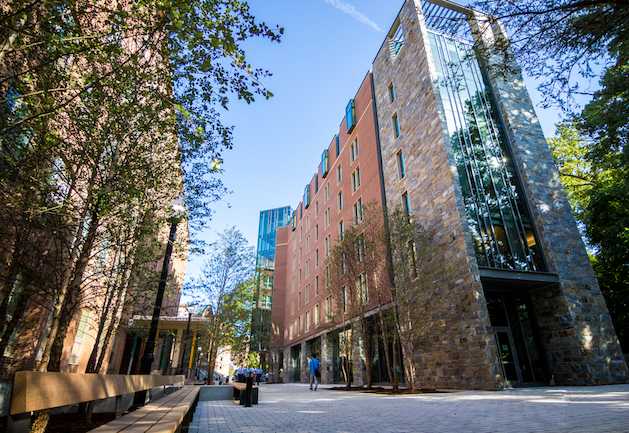Julianne Bruggemann (NHS ’23) was eating at the Leo J. O’Donovan Dining Hall when she got an email about a cluster of COVID-19 cases in Pedro Arrupe, S.J. Hall, where she lives. The statement said she needed to get tested within two days.
The Sept. 15 email from Dr. Ranit Mishori (MED ’02), Georgetown University’s chief public health officer, notified residents that three students who live together in Arrupe tested positive for COVID-19 within 36 hours. In an abundance of caution, Mishori informed residents they must get tested by Sept. 17; however, students were not required to quarantine unless they received an additional notice from the COVID-19 Care Navigation Team, according to a copy of the email obtained by The Hoya.

Bruggemann said that although the email was alarming, she was not overly concerned about it.
“I don’t really go into the Arrupe common spaces with people other than my roommates so I figured it was unlikely that I came into contact with positive cases,” Bruggemann wrote in a statement to The Hoya.
Hunter Mellon (COL ’23) was one of the students who tested positive for COVID-19. Mellon tested positive Sept. 15 and officials relocated him to the Georgetown University Hotel and Conference Center that same evening, around the same time Mishori’s email was sent to Arrupe Hall residents.
While it was safer to test everyone in the residence hall, Mellon said it may not have been completely necessary given that not everyone in the building had a high exposure to the virus.
“I think it’s a bunch of people who are very well intentioned probably who are trying to do the right thing, and who probably are doing the right thing, but it probably is a little bit of overkill because clearly not everybody in the building had had a high exposure risk,” Mellon said in a phone interview with The Hoya.
Mellon himself had not been in contact with anyone in Arrupe Hall after testing positive, he said.
The university tested residents of Arrupe to ensure their safety, according to a university spokesperson.
“Out of an abundance of caution and pursuant to CDC guidelines, we asked all residents to get tested for COVID-19 starting the next day, and expedited their results,” a university spokesperson wrote in an email to The Hoya.
According to Kenneth Boggess (SFS ’24), an Arrupe resident, some residents have shown a disregard for public health safety measures.
“I don’t blame the people who tested positive, but there are a lot of people in Arrupe who really don’t wear masks in a lot of common spaces, in the halls. And of course, it’s not just COVID, also the flu,” Boggess said in a phone interview with The Hoya. “There’s a very pervasive sense of almost entitlement, I’d say — of people saying that I don’t really care about public health, in the sense that I’m young, I’m fine.”
Bruggemann, however, appreciated the university’s proactive approach to the situation.
“Testing is an important part of ‘catching’ cases and while it is unlikely that everyone in the building interacted with these positive cases, I don’t think there was any harm in making everyone in the building test,” Bruggemann wrote.
The university has not recorded similar outbreaks in on-campus residence halls since the three Arrupe residents, according to a university spokesperson.
“We have not observed any further positive test results from Arrupe Hall residents, nor have we seen similar scenarios in other residence halls during this academic year,” a university spokesperson wrote in an email to The Hoya.
The week of Sept. 12, the university reported 34 positive COVID-19 tests on the main and Georgetown University Medical Center campuses, with a .52% positivity rate. These numbers reflect a .19% decrease from the previous week.
Boggess, who has previously lived with both immunocompromised and elderly family members, expressed overall frustration with the outbreak.
“Coming as someone who has an immunocompromised mother, lives with multiple elderly family members, we’ve always been careful about health. Because you know, the flu puts my mother in the hospital, the common cold puts my mother in the hospital,” Boggess said. “To come here and to be met with this kind of indifference from other people is really just frustrating.”
According to Bruggemann, the university took appropriate action to address the outbreak.
“The university has no way of knowing how we interact with one another, so they are trying to do what makes the most sense,” Bruggemann said.














